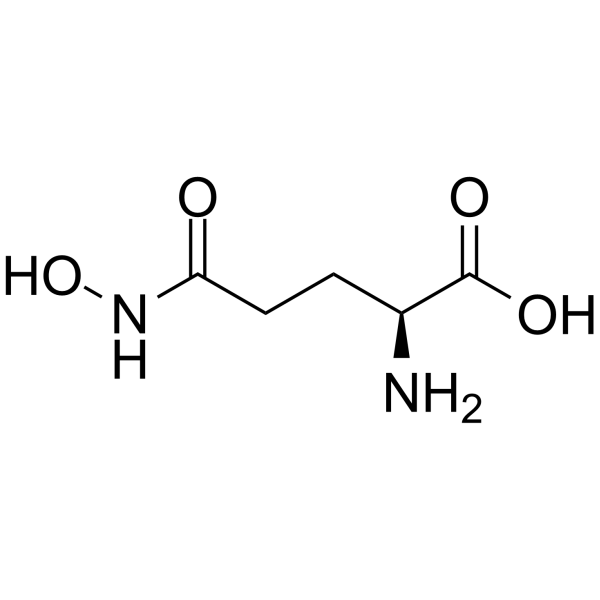L-Glutamic acid γ-monohydroxamate

L-Glutamic acid γ-monohydroxamate结构式

|
常用名 | L-Glutamic acid γ-monohydroxamate | 英文名 | L-GlutaMic acid γ-MonohydroxaMate |
|---|---|---|---|---|
| CAS号 | 1955-67-5 | 分子量 | 162.14400 | |
| 密度 | 1.432g/cm3 | 沸点 | 553.6ºC at 760mmHg | |
| 分子式 | C5H10N2O4 | 熔点 | N/A | |
| MSDS | 美版 | 闪点 | 288.6ºC |
|
Cell differentiation of Proteus mirabilis is initiated by glutamine, a specific chemoattractant for swarming cells.
Mol. Microbiol. 8(1) , 53-60, (1993) Swarming by Proteus mirabilis involves differentiation of typical short vegetative rods into filamentous hyperflagellated swarm cells which undergo cycles of rapid and co-ordinated population migration across surfaces and exhibit high levels of virulence gene... |
|
|
Alternative substrates for wild-type and L109A E. coli CTP synthases: kinetic evidence for a constricted ammonia tunnel.
Eur. J. Biochem. 271(21) , 4204-12, (2004) Cytidine 5'-triphosphate (CTP) synthase catalyses the ATP-dependent formation of CTP from uridine 5'-triphosphate using either NH(3) or l-glutamine as the nitrogen source. The hydrolysis of glutamine is catalysed in the C-terminal glutamine amide transfer dom... |
|
|
Effect of epidermal growth factor on glutamine metabolic enzymes in small intestine and skeletal muscle of parenterally fed rats.
Nutrition 13(7-8) , 652-5, (1997) Exogenous epidermal growth factor (EGF) markedly increases the in vivo uptake of glutamine by small intestine during total parenteral nutrition (TPN). Since glutamine is the major oxidative fuel for the small intestine and is synthesized mainly in skeletal mu... |
|
|
Selective cytotoxicity of L-glutamic acid gamma-monohydroxamate (GAH) for melanoma tumor cells.
Anticancer Res. 13(5A) , 1393-8, (1993) We have previously shown that L-glutamic acid gamma-monohydroxamate (GAH) exhibits an antitumor activity, both in vitro and in vivo. In this report we explore the selective cytotoxicity of GAH in vitro by comparing the survival of tumor and normal cells. GAH ... |
|
|
A sensitive method for the assay of glutamine synthetase.
Neurochem. Res. 15(3) , 301-5, (1990) The method for the assay of glutamine synthetase (GlnS) relies on the gamma-glutamyl transferase reaction, i.e. the formation of glutamyl-gamma-hydroxamate from glutamine and hydroxylamine, and the chromatographic separation of the reaction product from the r... |
|
|
Inhibition of malate-aspartate shuttle by the antitumor drug L-glutamic acid gamma-monohydroxamate in L1210 leukemia cells.
Int. J. Cancer 51(2) , 329-32, (1992)
|
|
|
Monohydroxamates of aspartic acid and glutamic acid exhibit antioxidant and angiotensin converting enzyme inhibitory activities.
J. Agric. Food Chem. 52 , 2386-90, (2004) Two monohydroxamates of l-aspartic acid beta-hydroxamate (AAH) and l-glutamic acid gamma-hydroxamate (GAH) were used for testing antioxidant and angiotensin converting enzyme (ACE) inhibitory activities in comparison with those of asparagine and glutamine, re... |
|
|
L-Glutamic acid gamma-monohydroxamate. A potentiator of vanadium-evoked glucose metabolism in vitro and in vivo.
J. Biol. Chem. 274 , 26617-26624, (1999) We report that the vanadium ligand L-Glu(gamma)HXM potentiates the capacity of free vanadium ions to activate glucose uptake and glucose metabolism in rat adipocytes in vitro (by 4-5-fold) and to lower blood glucose levels in hyperglycemic rats in vivo (by 5-... |
|
|
ATP-dependent inactivation of Escherichia coli gamma-glutamylcysteine synthetase by L-glutamic acid gamma-monohydroxamate.
Biosci. Biotechnol. Biochem. 62 , 1455-1457, (1998) Incubation of Escherichia coli gamma-glutamylcysteine synthetase with L-glutamic acid gamma-monohydroxamate and ATP caused slow but irreversible inhibition of the enzyme, and more than 90% activity was lost in three days. The enzyme was not inactivated when A... |
|
|
Organic vanadium chelators potentiate vanadium-evoked glucose metabolism in vitro and in vivo: establishing criteria for optimal chelators.
Mol. Pharmacol. 58 , 738-746, (2000) Several ligands, when complexed with vanadium, potentiate its insulinomimetic activity both in vivo and in vitro. We have recently found that L-Glu-gamma-monohydroxamate (HXM) and L-Asp(beta)HXM were especially potent in this regard. In the present study, we ... |